Exam Details
Exam Code
:300-510Exam Name
:Implementing Cisco Service Provider Advanced Routing Solutions (SPRI)Certification
:CCNP Service ProviderVendor
:CiscoTotal Questions
:210 Q&AsLast Updated
:Mar 27, 2025
Cisco CCNP Service Provider 300-510 Questions & Answers
-
Question 71:
Refer to the exhibit.
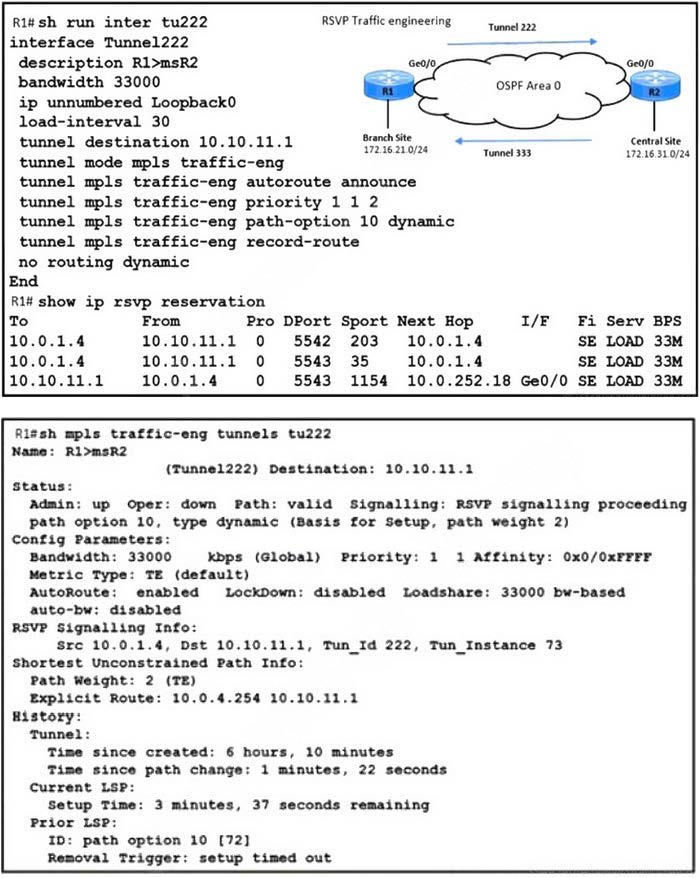
A network engineer is investigating a report of packet drops between the branch site and the central site.
1.
The two sites are connected via OSPF and RSVP-TE tunnels.
2.
Traffic from the central site to the branch site is passing normally.
3.
Technicians at both sites successfully ping the loopback IP addresses on routers R1 and R2.
Which configuration corrects the packet-drop problem?
A. R2(Config)# interface Tunnel333 R2(Config-if)# tunnel mpls traffic-eng bandwidth 33000
B. R1(Config)# interface Tunnel222 R1(Config-if)# tunnel mpls traffic-eng bandwidth 33000
C. R1(Config)# interface Ge0/0R1(Config-if)# ip rsvp bandwidth 33000 3300
D. R2(Config)# interface Ge0/0R2(Config-if)# ip rsvp bandwidth 33000 3300
-
Question 72:
Refer to the exhibit.
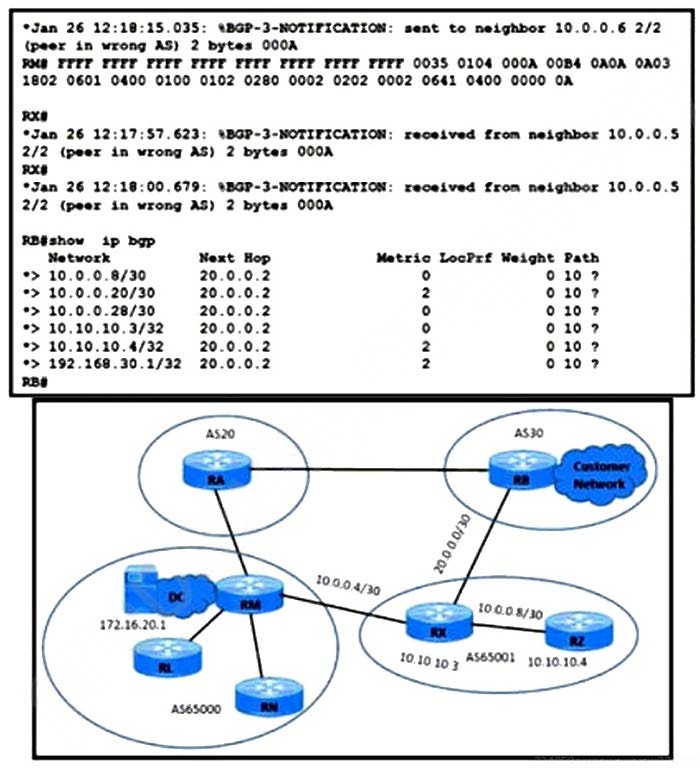
An engineer working for a private telecommunication company with an employee id: 4233:46:364 notices that the customer network going through AS30-AS65001-AS65000 is experiencing packet drops when it accesses an application at 172.16.20.1/32 In the DC cloud.
The BGP link between AS20 and AS30 is inaccessible because of a fiber cut. Routers RL, RN, and RZ are configured with confederation identifier 10.
Which action resolves this Issue?
A. RX(config)#router bgp 65001RX(config-router)# bgp confederation peers 65000
B. RB(config)#router bgp 30RB(config-router)# neighbor 10.10.10.3 remote-as 65001
C. RM(config)#router bgp 65000RM(config-router)# bgp confederation peers 65001
D. RX(config)#router bgp 65001RX(config-router)# no synchronizationRX(config-router)# bgp confederation identifier 10
-
Question 73:
Refer to the exhibit

While troubleshooting a networking issue an engineer identified a suboptimal communication issue on route reflector RR2 In the current environment:
1.
Router A is a non-route-reflector client for RR1 and RR2
2.
Routers D and E are directly connected iBGP peers.
3.
Router F is not an iBGP peer of routers D and E Which action resolves the issue?
A. Disable BGP Client-to-Client reflection on router RR2
B. Enable next-hop-self for BGP peering on router C
C. Remove the route-reflector configuration on router RR2
D. Enable next-hop-self for BGP peering on router D
-
Question 74:
Refer to the exhibit
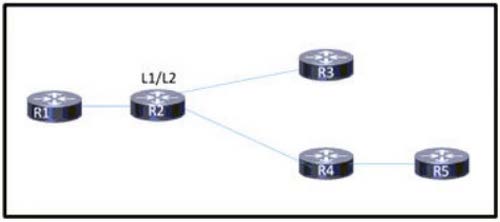
Reuters R2. R3, R4 and R5 all reside in the same area, with R1 in a different area R3 is overutilized and the engineer wants to reduce its CPU load
The engineer configured router R4 to summarize routes that it receives from R5. but R3 is still receiving all of the R5 routes.
Which action resolves the issue?
A. Configure R3 in a new area
B. Configure R2 as a Level 1 router
C. Configure the summary routes on R5
D. Configure R4 as a Level I-Level 2 router
-
Question 75:
Refer to the exhibit.

A customer reports that Host-1 is failing to receive streaming traffic from the IPTV source. The engineer has confirmed that hosts on router R2 are receiving traffic normally and that Host-1 is correctly sending subscription messages to join the IPTV stream. Which action must the engineer take to correct the problem?
A. Remove IP PIM SSM and IGMP from interface GigabitEthernet 1/0/1 on R3 and configure under global configuration
B. Configure IGMP version 3 under interface GigabitEthernet 1/0/1 on R3
C. Configure IP PIM SSM and IGMP version 2 under interface GigabitEthernet 1/0/1 on R3
D. Remove IP PIM SSM from the global configuration on R3 and configure it under the GigabitEthernet 1/0/1 interface
-
Question 76:
An engineer is troubleshooting slow performance issues on a customer's network after the last multicast configuration change was applied on it. While checking the running configuration on the router, the engineer notices there are many ip igmp join-group commands applied on several interfaces of the router which caused the high CPU utilization usage. What action must the engineer take to solve this issue?
A. Configure all router interfaces to be process-switched by increasing the query interval
B. Remove ip igmp join-group command on all unnecessary interfaces
C. Remove unnecessary members from the IGMP group
D. Configure ip igmp static-group command on all interfaces
-
Question 77:
Refer to the exhibit.
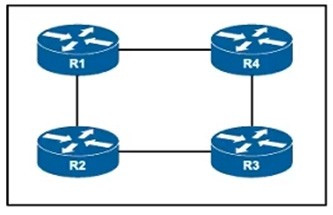
All routers on this network have been configured with PIM-SM, and R1 is the rendezvous point. However, when asymmetric routing is implemented to modify link usage, the network begins to drop certain multicast traffic. Which action corrects the problem?
A. Place the routes affected by asymmetric routing in a VRF
B. Remove the asymmetric routing and use spanning tree to manage link usage
C. Add a static mroute for routes that are failing
D. Configure the routers to use PIM-DM instead of PIM-SM
-
Question 78:
Refer to the exhibit.
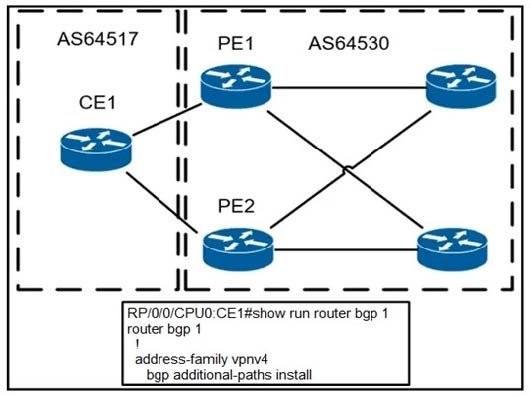
A network operator is configuring BGP PIC on CE1 on already established neighborships with PE1 and PE2 inside the fully converged MPLS network. Which element needs to be implemented to make this feature function effectively?
A. Bidirectional Forwarding Detection must be applied to the upstream facing BGP interfaces
B. The operator must ensure that all prefixes have the same next-hop from PE1 and PE2 for BGP PIC
C. A reserved BGP community of 1:10 must be used to denote the PIC feature set to the routing protocol
D. BGP import/export policies must be applied on all devices for the routes needing BGP for PIC
-
Question 79:
Refer to the exhibit.
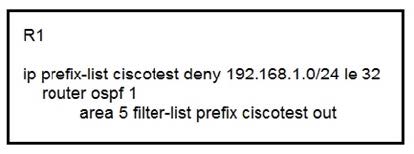
An engineer applied the configuration on R1 to prevent network 192.168.1.0/24 from being propagated outside of area 5. After the change, users have reported they are not able to access any of the application servers that were working before. While checking the routing table of the peer router, the engineer notices R1 stopped propagating any routes outside area 5. Which action must be taken to fix the problem?
A. Change the prefix-list action to permit and add an explicit deny statement for network 192.168.1.0/24
B. Add a permit statement for 0.0.0.0/0 le 32 to the end of the prefix-list to override the implicit deny
C. Reconfigure the filter-list statement to apply in the inbound direction
D. Configure an additional filter-list on R1 for inbound traffic to allow external routes into area 5
-
Question 80:
Which two differences should be considered when deciding whether to implement routing policies or route maps? (Choose two.)
A. Sequences are added after implementing a route map, but routing policies must be reconfigured when change is needed
B. Route maps are supported in Cisco IOS Software and routing policies are supported in Cisco IOS XR Software
C. Route maps are implemented using hierarchical policies, but routing policies must be implemented sequentially
D. Route maps require an explicit deny at the end of the sequence, but routing policies have an implicit deny at the end of the program
E. Route policies require sequence numbers, but route maps are implemented without sequencing
Related Exams:
300-510
Implementing Cisco Service Provider Advanced Routing Solutions (SPRI)300-515
Implementing Cisco Service Provider VPN Services (SVPI)300-535
Automating and Programming Cisco Service Provider Solutions (SPAUTO)350-501
Implementing and Operating Cisco Service Provider Network Core Technologies (SPCOR)
Tips on How to Prepare for the Exams
Nowadays, the certification exams become more and more important and required by more and more enterprises when applying for a job. But how to prepare for the exam effectively? How to prepare for the exam in a short time with less efforts? How to get a ideal result and how to find the most reliable resources? Here on Vcedump.com, you will find all the answers. Vcedump.com provide not only Cisco exam questions, answers and explanations but also complete assistance on your exam preparation and certification application. If you are confused on your 300-510 exam preparations and Cisco certification application, do not hesitate to visit our Vcedump.com to find your solutions here.